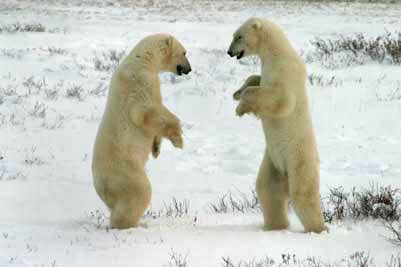This is an old revision of this page, as edited by Pcb21 (talk | contribs) at 13:08, 6 November 2003 (add image). The present address (URL) is a permanent link to this revision, which may differ significantly from the current revision.
Revision as of 13:08, 6 November 2003 by Pcb21 (talk | contribs) (add image)(diff) ← Previous revision | Latest revision (diff) | Newer revision → (diff)
| Polar Bear | ||||||||||||||
|---|---|---|---|---|---|---|---|---|---|---|---|---|---|---|
| File:Polar-bear-thumbnail.jpg The Polar bear Ursus maritimus Full-size image | ||||||||||||||
| Scientific classification | ||||||||||||||
| ||||||||||||||
| Binomial name | ||||||||||||||
| Ursus maritimus |
The polar bear (Thalarctos maritimus or Ursus maritimus) is a large mammal of the order Carnivora, family Ursidae. It is a circumpolar species found in and around the Arctic Ocean. It is the world's largest known land carnivore.
The polar bear is instantly recognisable by its white coat. Unlike other arctic mammals it never sheds this coat for a darker colour in summer. The hair is not actually pigmented white; it is unpigmented and hollow, like white hair in humans.
An interesting feature of the coat is that it appears black when photographed with ultraviolet light. A number of people have suggested that this is because the hairs channel the light to the black skin of the bear to help it stay warm during the cold, sunless winters. Measurements show, however, that the hairs strongly absorb violet and ultraviolet rays. This is why polar bear's pelt often appears yellow.
Bears are wonderfully insulated; to the point where they overheat at temperatures above 50°F.
It is the most completely carnivorous member of the bear family and feeds mainly on seals. Polar bears are superb swimmers and can often be seen in open waters miles from land. They also hunt very efficiently on land due to their prodigious speed; they are more than capable of outrunning a man. As a pure carnivore predating upon fish-eating carnivores, the polar bear ingests large amounts of vitamin A, which ends up stored in its liver: in the past, arctic explorers have been poisoned by eating polar bear liver.
Polar bears are currently threatened, not mainly by hunting, but by habitat loss caused by global warming; for example, the area of ice covering Hudson Bay in Northern Canada in winter is shrinking, limiting their access to seal prey. The sensitivity of the survival rates of the bears to global temperature is attested to by the population bulge in the cohort of bears born during the transient cooling that followed the erruption of Mount Pinatubo in 1991.
Two polar bears sparring. Taken near Churchill, Manitoba. Canada